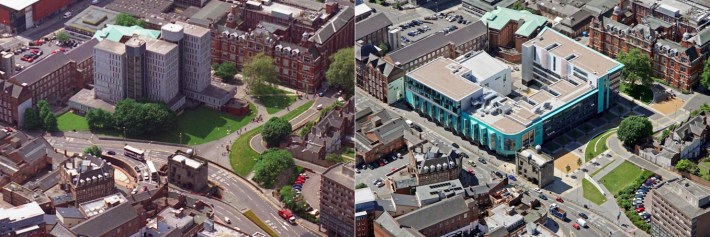
Leicester is a city of about 330,000 in England's East Midlands region. Like many other cities, it developed big mid-century plans to drive highways through its city center and paved over much of its historic core. In some cases, it even paved over its history: the bones of King Richard III, killed in battle nearby, were recently discovered beneath a parking lot. In the past decade, however, Leicester has unearthed more than just a king; it's also reclaimed space from the automobile and become a model for other cities looking to create more livable communities.
On Monday, Leicester's bicycle coordinator, Andy Salekeld, spoke at a fundraiser for Recycle-A-Bicycle and discussed the changes underway in his city.
In order to start shaping a new future for cities, Salkeld said, we have to start thinking of automobile dominance as an era in history. "We need to start talking about it as the past," he said, showing a slide of a mid-century gas station in Leicester that's received historic designation. "I take people on bike rides to see this," he said.
Beginning in 2008, Leicester pedestrianized some of its busiest downtown shopping streets. Salkeld said the city has seen a net increase in the number of people coming to the area, boosting the fortunes of merchants during an economic downturn. The city has had to work closely with advocates for the disabled, who are often worried that their needs will not be met in a "shared space" street, Salkeld said. The pedestrian streets program is expanding, using trials to test a concept before etching it in stone -- a tactic that Salkeld says they've learned from New York.
Another intervention that Leicester is borrowing from other cities is protected bicycle lanes. The Connecting Leicester project includes £7 million for new protected lanes on three major roads leading to the city center, in a bid to help bridge the divide created by the inner ring road, a tangle of flyover ramps and traffic lanes. That road itself is being shrunk, piece by piece, to make the city safer and more attractive for bicycling and walking.

Leicester's population is far more diverse than most English cities, and the city is a hub for immigrants in the region. Salkeld said it's important for advocates to reach out to all residents. A useful avenue for this outreach is Sky Ride, an annual series of free bike rides sponsored by a News Corporation subsidiary that attracted 16,000 riders last year. Many of the riders came from the city's Indian and African populations.
Another way the city has reached out is by creating education and bike skills programs modeled off those developed by Recycle-A-Bicycle in New York. "It's really important that we have organized programs," Salkeld said, adding that many communities might not otherwise have a tradition of bicycling. For many university students from immigrant families, Salkeld noted, driving a car to class is a status symbol, making it difficult to convince them to walk or bike instead.
While large cities like New York and London get lots of attention for their bike-share and infrastructure programs, Leicester often uses smaller cities for inspiration, like Dublin, Bristol, or Brighton. Salkeld said that he looks more to North American cities than European ones, since U.S. cities, like Leicester, have had to recover from auto-centric planning that wasn't as severe in many European cities.
In Britain, there has been significant recent action on the national level to support cycling as a primary transportation mode, with a landmark study, press campaign, and parliamentary recommendations building the momentum, with hopes that the government will move to fund a program to expand bicycling throughout the UK.





